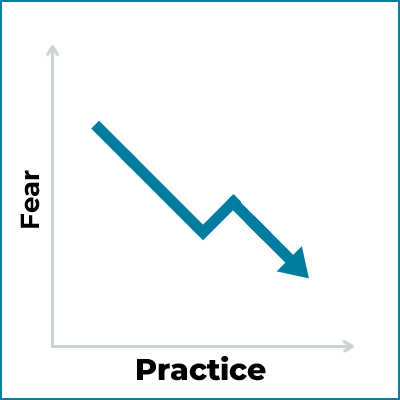ET
Exposure Therapy, which includes Exposure and Response Prevention is the behavioural component of cognitive behavioural therapy, in which individuals are supported to confront activities and events that cause them anxiety, distress and discomfort. It is a powerful component of CBT.

When individuals engage in Exposure Therapy, they will work with their therapist to confront objects, activities or situations that they have been avoiding. Through therapy, they will learn ways to tolerate the fear, anxiety and distress. This can be done through live behavioural exposures as well as imaginary exposures.
Exposure Therapy, which includes Exposure and Response Prevention therapy, is used within the context of treating OCD. This work allows people to face their fears and triggers without turning to their rituals and compulsions (whether they are behavioural or mental). Therapists will support individuals in learning a different relationship to their obsessions and intrusive thoughts during the work of Exposure and Response Prevention therapy.
Through repeated practice, individuals will often experience a decrease in anxiety or distress when they engage with difficult situations and triggers without relying on their rituals. Even when people do not experience a decrease in anxiety, they will learn something that they were not expecting. This new learning will replace the old learning. We also focus on carrying out exposure work that is meaningful to the individual as that helps them to live a life that is aligned with their values and the person that they want to be.
During Exposure Therapy and Exposure and Response Prevention therapy, individuals will work with their therapist to create what is called an exposure hierarchy. This can be thought of a road map to guide people to begin to approach what you have been avoiding. Working through a hierarchy can be done in a graduated manner or in a less systematic way. In either case, individuals learn to be present as they work through these items. And they are shown ways to shift towards what is important to them, even when facing things that can cause distress.
When people engage in Exposure Therapy and Exposure and Response Prevention therapy, we speak about the importance of this work being linked with our values. This often means choosing activities and actions for exposure work that is meaningful to us and that would enhance our lives if we stopped avoiding them. This is aligned with Acceptance and Commitment Therapy interventions. In this way, Exposure Therapy and Exposure and Response Prevention therapy takes us closer to our values and what matters to us in our lives. We must learn to make room for difficult thoughts and feelings that emerge when doing Exposure Therapy and Exposure and Response Prevention therapy. In order to do this, you will learn skills and tools with your therapist. This will allow for you to set goals and start committed action towards important activities in your life.
Behavioural experiments can also be thought of as a type of exposure therapy. This therapeutic approach allows individuals to make predictions about situations they have been avoiding or are fearful of. Individuals will then plan and carry out these experiments in order to test out their predictions. The outcomes of these experiments are discussed within the context of therapy and allow individuals to gain important insight. All information is important and useful as we learn more about how real life situations turn out together.
Exposure Therapy is used within the context of many different anxiety disorders. Individuals with social anxiety, generalized anxiety, phobias and panic disorder all benefit greatly from this powerful behavioural strategy. Within the context of carrying out exposure work, individuals learn that they can handle things that they never thought they could. Individuals with perfectionistic tendencies also benefit from exposure work.
At FTPS, we use Exposure Therapy and Exposure and Response Prevention therapy for our clients presenting with OCD, OCD-Related Disorders, and Anxiety Disorders. Even therapy for depression has elements of exposure work as we gradually approach activities that we have been avoiding due to low mood and motivation. Overall, Exposure Therapy is powerful and is considered to be transdiagnostic. This means that individuals with all different types of presenting issues have been shown to have great benefits when this approach is used in therapy. Exposure therapy can be conducted through online therapy and often allows for you to receiving coaching to approach triggers within your own home environment.


